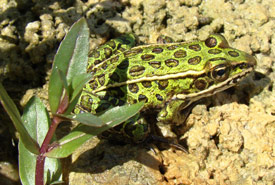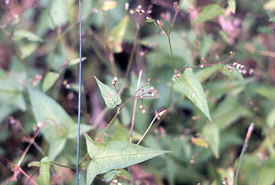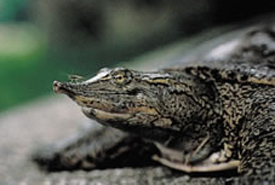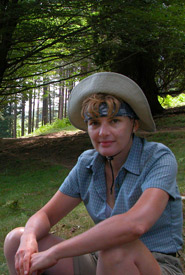Lending nature a hand

Northern leopard frog (Photo by NCC)
If you are a nature lover like myself, you may be interested in participating in one of the many yearly activities organized by the Quebec branch of the Nature Conservancy of Canada (NCC). The activities are open to all — you do not need a science background — and even children can participate. On August 8, I joined a group of volunteers led by NCC representatives on a mission to clean up the Missisquoi Bay Nature Refuge, near Lake Champlain, at St-Armand, Quebec. Our efforts would help maintain the quality of the Refuge’s wetland and shorelines.
We set off from NCC's Montreal office around 8:30 a.m. On the ride to St-Armand, project manager Carine Deland briefed us about the site and NCC's mission, as Canada’s leading national land conservation organization.
I know Missisquoi Bay from childhood visits to area beaches. The large, circular bay with a view of the Adirondack Mountains in the distance is peaceful and beautiful. Its shallowness makes it ideal for water sports but at the same time ecologically very vulnerable.

Halberd-leaved smartweed (Photo by R. H. Mohlenbrock)
The Missisquoi Bay Nature Refuge consists of a narrow wooded area separated from the shoreline by a wetland and a strip of shoreline, both about half a kilometre long. The wooded area is private and not normally accessible to visitors. The shoreline is open to the public and features a nature trail with educational signage.
Our day’s activity involved removing trash that had been left behind by significant flooding of the lake in recent years. All kinds of material (wood, metal, plastic, etc.) had to be moved out.
Our day was split in two: in the morning we would clean up the wooded part of the property and in the afternoon we would move to the shoreline. Armed with shovels and garbage bags and well protected with long-sleeved clothing, bug spray and work gloves, we set off into the woods.
Picking up the trash, I got intimate with the many species of flora and fauna on the property, including some species considered rare and unique to the area. Biologist Caroline Tanguay pointed out foreign invasive species such as the beautiful but problematic purple loostrife, common reed, which overwhelms native wetland species, and creeping Jenny, a popular ground cover that has escaped gardens and is aggressively carpeting the forest floor. She also showed me a rare distinctive vine that I had never noticed before called Halberd-leaved smartweed.
The area is especially rich in plant life and I was able to identify, amongst other species, forget-me-nots, wild mint, stinging nettles and…poison ivy.
I readily identified the deer tracks in the mud as well as the tiny handprints of raccoons. As I waded through the damp undergrowth, leopard frogs jumped about. At one point I surprised a killdeer — it flew in a burst from the undergrowth and I recognized its dark neckband and bright orange-buff rump. An owl hooted from the nearby wetland. Fortunately, there were far fewer flies and mosquitos than expected.
We worked all morning and amassed a mountain of trash — plastics of all kind, glass bottles, rusted steel drums and paint cans, tires, carpeting, metal building materials, porcelain toilets smashed into pieces, you name it. Some items rested on the ground and were easy to scoop up, other were half buried and necessitated the use of the shovel. The morning’s efforts were very fruitful and we watched with pride as the large cart full of trash was hauled away.

Spiny softshell turtle (Photo by NCC)
Over lunch by the shore we discussed one of the major issues concerning the health of the bay: the presence of blue algae. Caroline pointed out the green soup that tinged the rocks along the shore bright blue; it looked as if someone had spilled paint all over.
The algae produce neurotoxins dangerous to humans and animals, and as a result part of the bay is off limits to swimmers. The algae blooms are the result of a high level of phosphates in the water that causes the algae to overgrow and rob the water of the oxygen necessary to sustain other species. The phosphates come mainly from agricultural runoff into streams and rivers that feed into the bay. Efforts are now being made to prevent the runoff from reaching the waterways.
In the afternoon, we headed to the shore to continue our work. While picking up the trash, I would pause now and then to read the educational signage about the area’s geology, birds and fish species, among other things.
One of the most interesting facts I learned is that the shore is the nesting ground of a threatened species, the spiny softshell turtle. It is the only area of confirmed sightings of the species in Quebec. Female turtles lay their eggs in the sand in June. Predation, changing shorelines and certain recreational activities such as motorized boating, all threaten this species’ survival. I could not help thinking how the blue algae could affect the turtles.
Our shoreline effort yielded another pile of trash, not as big as the first but equally satisfying. I felt good that plastic bags and other refuse that might have posed a danger to wildlife were eliminated. After a day of hard work and discovery I was left with a feeling of accomplishment and satisfaction that our efforts have brought a noticeable change to the Missisquoi Bay Nature Refuge’s environment.
For more information about the Nature Conservancy of Canada’s (NCC’s) Conservation Volunteers program, please contact volunteer coordinator Lucie Veillette at 514 876-1606 ext. 296 or quebec@conservationvolunteers.ca.
The article was first published on Westmountmag.ca.


